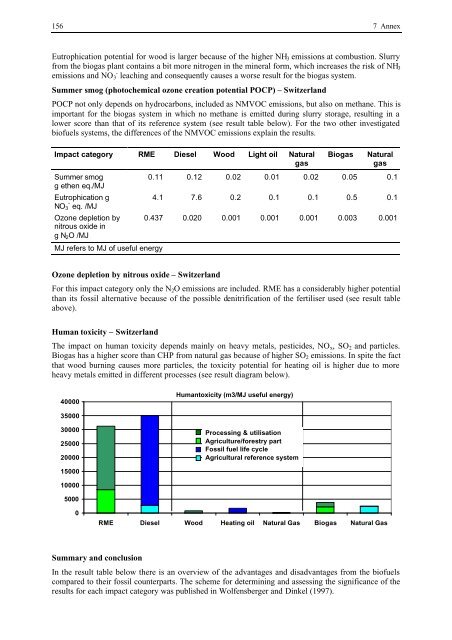BIOENERGY FOR EUROPE: WHICH ONES FIT BEST?
BIOENERGY FOR EUROPE: WHICH ONES FIT BEST?
BIOENERGY FOR EUROPE: WHICH ONES FIT BEST?
Create successful ePaper yourself
Turn your PDF publications into a flip-book with our unique Google optimized e-Paper software.
156 7 Annex<br />
Eutrophication potential for wood is larger because of the higher NH3 emissions at combustion. Slurry<br />
from the biogas plant contains a bit more nitrogen in the mineral form, which increases the risk of NH3<br />
emissions and NO3 - leaching and consequently causes a worse result for the biogas system.<br />
Summer smog (photochemical ozone creation potential POCP) – Switzerland<br />
POCP not only depends on hydrocarbons, included as NMVOC emissions, but also on methane. This is<br />
important for the biogas system in which no methane is emitted during slurry storage, resulting in a<br />
lower score than that of its reference system (see result table below). For the two other investigated<br />
biofuels systems, the differences of the NMVOC emissions explain the results.<br />
Impact category RME Diesel Wood Light oil Natural<br />
gas<br />
Summer smog<br />
g ethen eq./MJ<br />
Eutrophication g<br />
NO3 - eq. /MJ<br />
Ozone depletion by<br />
nitrous oxide in<br />
g N2O /MJ<br />
MJ refers to MJ of useful energy<br />
Ozone depletion by nitrous oxide – Switzerland<br />
Biogas Natural<br />
gas<br />
0.11 0.12 0.02 0.01 0.02 0.05 0.1<br />
4.1 7.6 0.2 0.1 0.1 0.5 0.1<br />
0.437 0.020 0.001 0.001 0.001 0.003 0.001<br />
For this impact category only the N2O emissions are included. RME has a considerably higher potential<br />
than its fossil alternative because of the possible denitrification of the fertiliser used (see result table<br />
above).<br />
Human toxicity – Switzerland<br />
The impact on human toxicity depends mainly on heavy metals, pesticides, NOx, SO2 and particles.<br />
Biogas has a higher score than CHP from natural gas because of higher SO2 emissions. In spite the fact<br />
that wood burning causes more particles, the toxicity potential for heating oil is higher due to more<br />
heavy metals emitted in different processes (see result diagram below).<br />
40000<br />
35000<br />
30000<br />
25000<br />
20000<br />
15000<br />
10000<br />
5000<br />
0<br />
Summary and conclusion<br />
Humantoxicity (m3/MJ useful energy)<br />
Processing & utilisation<br />
Agriculture/forestry part<br />
Fossil fuel life cycle<br />
Agricultural reference system<br />
RME Diesel Wood Heating oil Natural Gas Biogas Natural Gas<br />
In the result table below there is an overview of the advantages and disadvantages from the biofuels<br />
compared to their fossil counterparts. The scheme for determining and assessing the significance of the<br />
results for each impact category was published in Wolfensberger and Dinkel (1997).

















